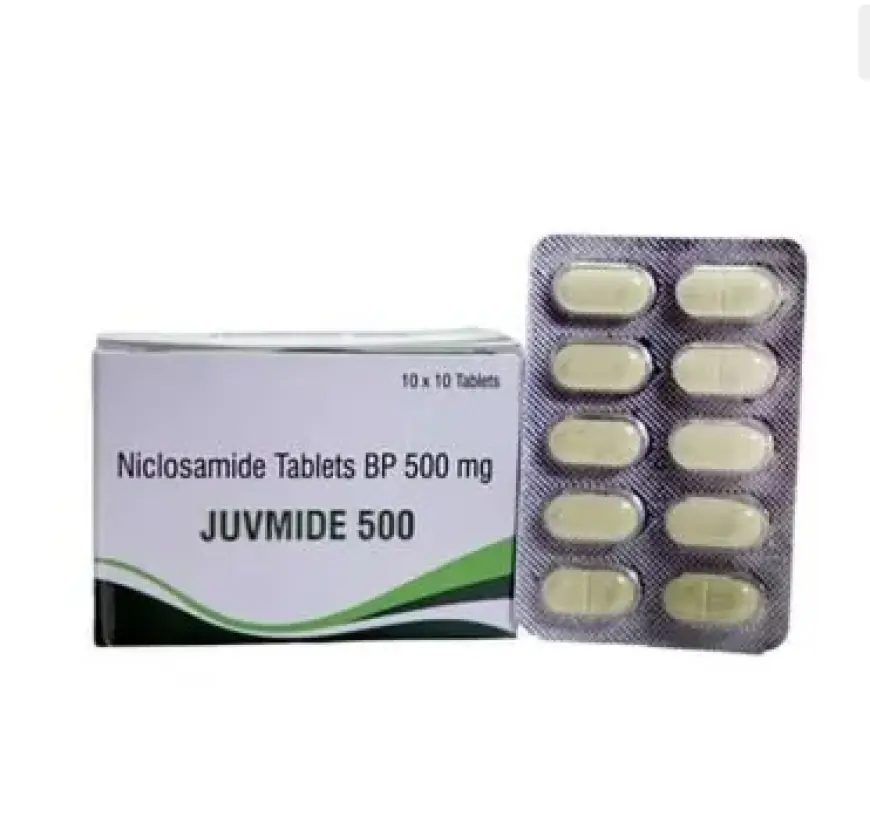Niclosamide: How It Works to Kill Parasites
Niclosamide is an anthelmintic drug, which means it’s designed to expel or destroy parasitic worms (helminths).

Parasitic infections remain a significant global health concern, especially in areas with poor sanitation and limited access to medical care. Among the treatments available, Niclosamide stands out as a highly effective and well-tolerated antiparasitic medication, especially for intestinal tapeworms. Approved for use for several decades, Niclosamide has proven its value in eliminating parasites safely and efficiently. In this article, we’ll explore how Niclosamide works to kill parasites, its applications, dosage, and important safety considerations.
What Is Niclosamide?
Niclosamide is an anthelmintic drug, which means it’s designed to expel or destroy parasitic worms (helminths). It is particularly effective against cestodes, or tapeworms, which can infect the human intestines through consumption of contaminated food, particularly undercooked beef or pork. You can also Buy Niclosamide Online from dosepharmacy.
Niclosamide has been included on the World Health Organization's List of Essential Medicines, underlining its importance in global public health. It's primarily used in tablet form and taken orally.
Types of Parasites Niclosamide Targets
Niclosamide is most effective against the following tapeworm species:
-
Taenia saginata (beef tapeworm)
-
Taenia solium (pork tapeworm)
-
Diphyllobothrium latum (fish tapeworm)
-
Hymenolepis nana (dwarf tapeworm)
It does not work against other types of parasites such as roundworms or flukes.
How Does Niclosamide Work in the Body?
Niclosamide’s antiparasitic effects are primarily localized to the intestinal tract, as the drug is poorly absorbed into the bloodstream. This is beneficial, as the target parasites reside in the intestines and limited absorption helps minimize systemic side effects.
1. Inhibits Energy Production in Parasites
The primary mechanism of action of Niclosamide is the inhibition of oxidative phosphorylation in the parasite’s mitochondria. This disrupts the parasite's ability to generate adenosine triphosphate (ATP)—the molecule that fuels most biological processes.
By halting ATP production, Niclosamide essentially starves the tapeworm, leading to its paralysis and eventual death.
2. Blocks Glucose Uptake
In addition to interrupting energy production, Niclosamide also impairs the parasite's ability to absorb glucose. Since glucose is the primary source of energy for the tapeworm, this further weakens and depletes its energy reserves.
3. Destroys the Scolex (Head of Tapeworm)
Niclosamide is effective in destroying the scolex, or head of the tapeworm. This is crucial because if the scolex remains attached to the intestinal wall, the parasite can regenerate. By removing the scolex, Niclosamide ensures complete eradication of the tapeworm.
How Is Niclosamide Taken?
Niclosamide is available in chewable or crushable tablets, typically 500 mg in strength. It is taken orally, and doctors may advise patients to chew or crush the tablets before swallowing to increase its contact with the parasite.
Common Dosage Guidelines:
-
Adults: Usually a single dose of 2 g for most tapeworms.
-
Children (over 2 years): Dosage is typically weight-based, often around 1–1.5 g.
A laxative may be prescribed a few hours after taking Niclosamide to help expel the dead tapeworm from the body.
Note: Always follow the dosage instructions provided by a healthcare professional.
How Quickly Does Niclosamide Work?
Niclosamide begins working within hours after ingestion. Dead parasites or parts of the tapeworm may appear in the stool within 24–48 hours. However, a follow-up stool test may be needed after a few weeks to confirm that the infection has been fully cleared.
Advantages of Niclosamide
-
High Efficacy: Especially effective against common intestinal tapeworms.
-
Minimal Systemic Side Effects: Due to poor absorption in the GI tract.
-
Simple Dosing: Often requires just a single dose.
-
Well-Tolerated in Children and Adults
Potential Side Effects
Although generally safe, Niclosamide can cause mild side effects in some individuals. These may include:
-
Nausea or vomiting
-
Abdominal pain
-
Diarrhea
-
Lightheadedness
-
Unpleasant taste
Severe side effects are rare, and allergic reactions are uncommon. If symptoms like rashes, swelling, or difficulty breathing occur, seek immediate medical attention.
Who Should Avoid Niclosamide?
While Niclosamide is generally safe, some groups should avoid it or use it under strict medical supervision:
-
Children under 2 years (unless prescribed by a doctor)
-
Pregnant or breastfeeding women (only if benefits outweigh risks)
-
Patients with known allergies to Niclosamide
Tips for Safe Use
-
Take after a light meal to maximize its effectiveness.
-
Crush or chew the tablets if possible for better intestinal contact.
-
Use a laxative if prescribed to help expel the tapeworm.
-
Follow up with your doctor to ensure complete removal of the parasite.
Resistance and Emerging Uses
While resistance to Niclosamide is not a major issue, researchers are investigating other uses for the drug. Recent studies have explored its potential in:
-
Cancer therapy: Due to its ability to disrupt mitochondrial activity.
-
COVID-19 research: As a possible antiviral agent.
-
Zoonotic infections: In animals and humans alike.
These applications are still under investigation and are not yet approved for clinical use.
Niclosamide remains one of the most reliable treatments for intestinal tapeworm infections. Its ability to directly target the parasite’s energy production system makes it fast-acting and effective. With minimal absorption and side effects, it is a preferred option for both adults and children over 2 years old.
If you suspect a tapeworm infection or have been diagnosed with one, consult your healthcare provider to determine if Niclosamide is the right choice for you. When used correctly, this powerful antiparasitic can help you regain your health with minimal discomfort and rapid results.
What's Your Reaction?
 Like
0
Like
0
 Dislike
0
Dislike
0
 Love
0
Love
0
 Funny
0
Funny
0
 Angry
0
Angry
0
 Sad
0
Sad
0
 Wow
0
Wow
0
















































